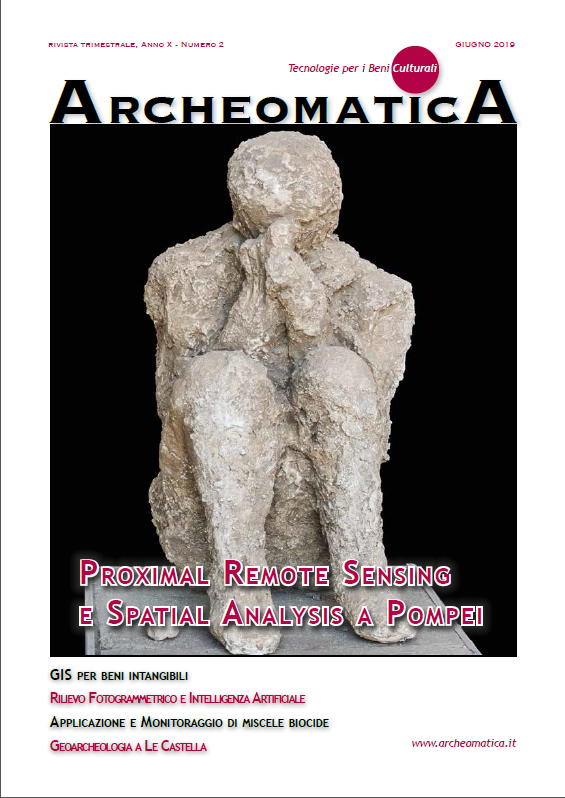Applicazione e Monitoraggio di miscele biocide per pulitura di superfici attaccate da patina biologica
DOI:
https://doi.org/10.48258/arc.v10i2.1573Parole chiave:
patina biologica, biocida, olio essenziale, bioluminescenzaAbstract
Abstract: The aim of the present study is to identify and characterise the best biocidal formulation for controlling biodeterioration phenomena. Given the requirements which define a good biocide, i.e. being environmentally sustainable, negligible interference with stone materials, being safe from a toxicological point of view, being easy to apply, having long-lasting effect, and being cost effective, the overall objective is to minimise environmental impact by ensuring an efficient use of resources. The attainments of our approach have been:protection of operators' and end users' health, sustainability, reversibility, compatibility and minimal intervention criterion.
The specific objectives of this work are articulated in 4 points:
1. Recording of metabolic activity of the active patinas present upon the artefact surface, grown in spontaneous environmental conditions
2. Registration of the data on effectiveness of commercial biocidal mixtures, applied to real case studies, by Bioluminescence analyses
3. Create a connection system to collect all the recorded data in order to compare mixtures applied on different materials with objective values.
4. Monitoring over time of the mixtures applied, aiming to recording biocidal efficiency andpossible chromatic alterations.
Riferimenti bibliografici
Caneva G, Nugari MP, Salvadori O, 2008. Plant Biology for Cultural Heritage. Getty Conservation Institute, Los Angeles: 1-408.
Caneva G, Terscari M, 2017. Stone biodeterioration: treatments and and preventive conservation. Proceedings of 2017 International Symposium of Stone Conservation, Conservation Technologies for Stone Cultural Heritages: Status and Future Prospects.
Cuzman OA, Camaiti M, Sacchi B, Tiano P, 2011. Natural antibiofouling agents as new control method for phototrophic biofilms dwelling on monumental stone surfaces. Int J Conserv Sci 2(1):3-16.
Cuzman OA, Tiano P, Ventura S, 2008. New control methods against biofilms' formation on the monumental stones. In: Lukaszewicz JW, Niemcewicz P, 11th International Congress on Deterioration and Conservation of Stone, 15-20 September 2008, Torun, Poland; Proceedings, vol. 2:837-846.; Nicolaus Copernicus University Press, Torun (POL).
Hueck-van der Plas EH, 1965. The biodeterioration of materials as a part of hylobiology. Mater Organismen, 1:5–34.
Jeong SH, Lee HJ, Kim DW, Chung YJ, 2018. New biocide for eco-friendly biofilm removal on outdoor stone monuments. Int Biodeterior Biodegrad 131:19-28.
Levinskaitć— L, Paškevićius A, 2013. Fungi in Water-Damaged Buildings of Vilnius Old City and Their Susceptibility Towards Disinfectants and Essential Oils. Indoor Built Environ 22(5):766-775.
Mansour M, Ahmed H, 2012. Occurrence of fungi on some deteriorated ancient Egyptian materials and their controlling by ecofriendly products. EJARS 2(2): 91-101.
Mansour MM, 2013. Proactive Investigation using Bioagents and Fungicide for Preservation of Egyptian Stone Sarcophagus. JASR 9(3):1917-1930.
Maxim D, Bucşa L, Moza MI, Chachula O, 2012. Preliminary antifungal investigation of ten biocides against moulds from two different church frescoes. Ann RSCB Vol. XVII, Issue 2, 139-146.
Mironescu M, Georgescu C, 2010. Activity of some essential oils against common spoilage fungi of buildings. Acta Universitatis Cibiniensis, Series E: Food Technology 14(2).
Pinna D, Salvadori O, 2008. Processes of Biodeterioration: General Mechanisms. In: Caneva G, Nugari MP, Salvadori O. Plant Biology for Cultural Heritage. Biodeterioration and Conservation. Getty Publications, Los Angeles, USA.
Rotolo V, Barresi G, Di Carlo E, Giordano A, Lombardo G, Crimi E, Costa E, Bruno M, Palla F, 2016. Plant extracts as green potential strategies to control the biodeterioration of cultural heritage. Int J Conserv Sci 7(Specialissue2):839-46.
Sakr AA, Ghaly MF, Abdel-Haliem MSF, 2012. The efficacy of specific essential oils on yeasts isolated from the royal tomb paintings at Tanis, Egypt. Int J Conserv Sci 3(2):87-92.
Savković ŽD, Stupar MČ, Grbić MVL, Vukojević JB, 2016. Comparison of anti-Aspergillus activity of Origanum vulgare L. essential oil and commercial biocide based on silver ions and hydrogen peroxide. Acta Bot Croat 75(1):121-8.
Stupar M, Grbić ML, Džamić A, Unković N, Ristić M, Jelikić A, Vukojević J, 2014a. Antifungal activity of selected essential oils and biocide benzalkonium chloride against the fungi isolated from cultural heritage objects. S Afr J Bot 93:118-24.
Stupar M, Grbić ML, Simić GS, Jelikić A, Vukojević J, Sabovljević M, 2014b. A sub-aerial biofilms investigation and new approach in biocide application in cultural heritage conservation: Holy Virgin Church (Gradac Monastery, Serbia). Indoor Built Environ 23(4):584-93.
UNI NORMAL 11182, 2006. Cultural heritage. Natural and artificial stone: Description of the alteration - Terminology and definition
Veneranda M, Blanco-Zubiaguirre L, Roselli G, Di Girolami G, Castro K, Madariaga JM, 2017. Evaluating the exploitability of several essential oils constituents as a novel biological treatment against cultural heritage biocolonization. Microchem J 138:1-6.
S.H. Jeong et al. / International Biodeterioration & Biodegradation xxx (2017) 1e10
J.-Y. Maillard, 2002. Bacterial target sites for biocide action, Journal of Applied Microbiology Symposium Supplement 2002, 92, 16S–27S.
Scientific Committee on Emerging and Newly Identified Health Risks Assessment of the Antibiotic Resistance Effects of Biocides The SCENIHR adopted this opinion at the 28th plenary on 19 January 2009 after public consultation. European Commission Health & Consumer Protection DG, European Commission 2009
Dowloads
Pubblicato
Fascicolo
Sezione
Licenza
Gli autori che pubblicano su questa rivista accettano le seguenti condizioni:- Gli autori mantengono i diritti sulla loro opera e cedono alla rivista il diritto di prima pubblicazione dell'opera, contemporaneamente licenziata sotto una Licenza Creative Commons - Attribuzione che permette ad altri di condividere l'opera indicando la paternità intellettuale e la prima pubblicazione su questa rivista.
- Gli autori possono aderire ad altri accordi di licenza non esclusiva per la distribuzione della versione dell'opera pubblicata (es. depositarla in un archivio istituzionale o pubblicarla in una monografia), a patto di indicare che la prima pubblicazione è avvenuta su questa rivista.
- Gli autori possono diffondere la loro opera online (es. in repository istituzionali o nel loro sito web) prima e durante il processo di submission, poiché può portare a scambi produttivi e aumentare le citazioni dell'opera pubblicata (Vedi The Effect of Open Access).





